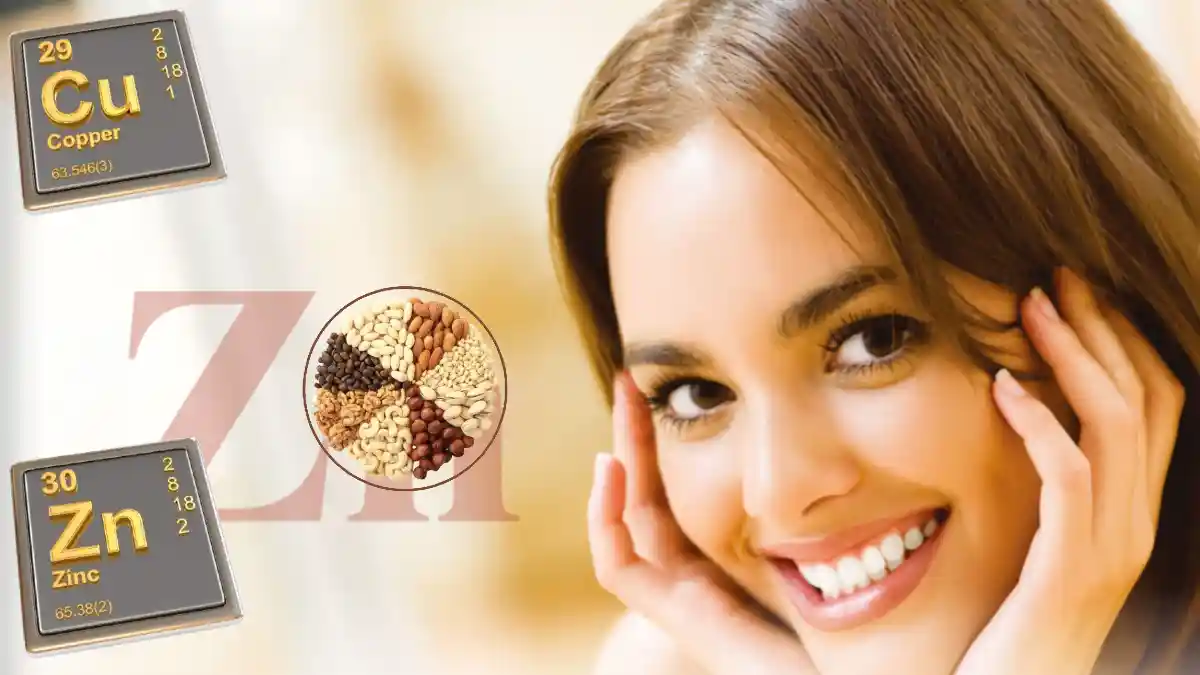Zinc & Copper
സിങ്ക്

മനുഷ്യശരീരത്തിൽ 2-4 ഗ്രാം സിങ്ക് വിതരണം ചെയ്യപ്പെടുന്നു. സിങ്കിൻ്റെ ഭൂരിഭാഗവും തലച്ചോറ്, പേശികൾ, എല്ലുകൾ, വൃക്കകൾ, കരൾ എന്നിവയിലാണ്, പ്രോസ്റ്റേറ്റ് ഗ്രന്ഥിയിലും കണ്ണിൻ്റെ ഭാഗങ്ങളിലും ഏറ്റവും ഉയർന്ന സാന്ദ്രതയുണ്ട്. ഭക്ഷണത്തിലൂടെ എടുക്കുന്ന 40% സിങ്ക് ശരീരത്തിൽ ആഗിരണം ചെയ്യപ്പെടുന്നു.
പ്രവർത്തനങ്ങൾ
ശരീരത്തിലെ ജൈവ പ്രതിപ്രവർത്തനങ്ങൾക്ക് ഉപയോഗിക്കുന്ന എല്ലാ എൻസൈമുകളുടെയും ഒരു ഘടകമാണ് സിങ്ക്. പ്രോട്ടീൻ സമന്വയത്തിന് ഇത് ആവശ്യമാണ്. ടിഷ്യൂകളുടെ വളർച്ചയിലും അറ്റകുറ്റപ്പണിയിലും ഇത് ഒരു പ്രധാന പങ്ക് വഹിക്കുന്നു. ശരീരത്തിൻ്റെ പ്രതിരോധശേഷി വർധിപ്പിച്ച് മുറിവ് ഉണക്കുന്ന പ്രക്രിയ വേഗത്തിലാക്കുകയും ചുമ, ജലദോഷം എന്നിവ ഭേദമാക്കാൻ ഇത് ഉപയോഗപ്രദമാണ്. ചർമ്മം, മുടി, നഖം എന്നിവയുടെ സംരക്ഷണത്തിന് ഇത് ഒരു പ്രധാന ധാതുവാണ്. അസ്ഥി ധാതുവൽക്കരണം, തൈറോയ്ഡ് പ്രവർത്തനം, രക്തം കട്ടപിടിക്കൽ, ബീജ ഉത്പാദനം എന്നിവയ്ക്ക് സിങ്ക് ആവശ്യമാണ്.


കുറവ് ലക്ഷണങ്ങൾ
വളർച്ചാ മന്ദത, മുറിവുണങ്ങാൻ വൈകൽ, അണുബാധയുടെ ആവൃത്തി, ചുമയും ജലദോഷവും, പൊട്ടാൻ സാധ്യതയുള്ള ദുർബലമായ മുടിയും നഖങ്ങളും, ദുർബലമായ എല്ലുകളും, ക്ഷീണവും ലൈംഗികാഭിലാഷവും വന്ധ്യതയും നഷ്ടപ്പെടുന്നു.
ഉറവിടങ്ങൾ
പരിപ്പ്, എണ്ണക്കുരു എന്നിവയിൽ നല്ല അളവിൽ സിങ്ക് അടങ്ങിയിട്ടുണ്ട്.
ആവശ്യം
പുരുഷന്മാർക്ക് 14 മില്ലിഗ്രാം / ദിവസം, സ്ത്രീകൾക്ക് 9.8 മില്ലിഗ്രാം / ദിവസം (WHO ശുപാർശ). അപകടങ്ങളോ ഏതെങ്കിലും തരത്തിലുള്ള ശസ്ത്രക്രിയയ്ക്ക് ശേഷമോ, മുറിവുകൾ വേഗത്തിൽ സുഖപ്പെടുത്തുന്നതിന്, പ്രതിദിനം 50 മില്ലിഗ്രാം സിങ്ക് കഴിക്കുന്നത് ശുപാർശ ചെയ്യുന്നു. അണുബാധ, ചുമ, ജലദോഷം എന്നിവയുടെ കാര്യത്തിലും ചർമ്മത്തിൻ്റെയും മുടിയുടെയും ഘടന മെച്ചപ്പെടുത്തുന്നതിനും സിങ്ക് സപ്ലിമെൻ്റേഷൻ ആവശ്യമാണ്.
ചെമ്പ്

പ്രായപൂർത്തിയായ മനുഷ്യശരീരത്തിൽ ഏകദേശം 75-150 മില്ലിഗ്രാം ചെമ്പ് അടങ്ങിയിട്ടുണ്ട്. വിവിധ എൻസൈമുകളുടെ ഒരു ഘടകമാണ് ചെമ്പ്, ഇത് രക്തത്തിലെ നിരവധി പ്രോട്ടീനുകളുമായി സംയോജിപ്പിച്ചിരിക്കുന്നു. പ്രതിദിനം ഏകദേശം 2 മില്ലിഗ്രാം ആണ് ചെമ്പിൻ്റെ ഏകദേശ ഭക്ഷണ ഉപഭോഗം. കഴിക്കുന്ന ഭക്ഷണത്തിൻ്റെ തരം അനുസരിച്ച് ചെമ്പ് ആഗിരണം 5-33% വരെ വ്യത്യാസപ്പെടുന്നു. ഉയർന്ന അളവിലുള്ള സിങ്ക്, വിറ്റാമിൻ സി എന്നിവ ചെമ്പ് ആഗിരണത്തെ തടസ്സപ്പെടുത്തും. ചെമ്പ് കുടലിൽ ആഗിരണം ചെയ്യപ്പെടുകയും തുടർന്ന് കരളിലേക്ക് കൊണ്ടുപോകുകയും ചെയ്യുന്നു. കരളിൽ പ്രോസസ്സ് ചെയ്ത ശേഷം, ചെമ്പ് രണ്ടാം ഘട്ടത്തിൽ മറ്റ് ടിഷ്യൂകളിലേക്ക് വിതരണം ചെയ്യുന്നു. ശരീരത്തിൻ്റെ വിവിധ ഭാഗങ്ങളിലേക്ക് ചെമ്പ് കൊണ്ടുപോകുന്നത് ഒരു പ്രോട്ടീൻ വഴി സുഗമമാക്കുന്നു.
പ്രവർത്തനങ്ങൾ
ഹീമോഗ്ലോബിൻ്റെ രൂപീകരണത്തിന് ഇരുമ്പിനൊപ്പം ചെമ്പും ആവശ്യമാണ്. ഊർജ്ജത്തിൻ്റെ ബയോകെമിക്കൽ റിലീസിൽ ഇത് ഉൾപ്പെടുന്നു. ചർമ്മത്തിൻ്റെ നിറത്തിന് കാരണമാകുന്ന കൊളാജൻ പ്രോട്ടീനിൻ്റെയും മെലാനിൻ പിഗ്മെൻ്റിൻ്റെയും രൂപീകരണത്തിന് ആവശ്യമായ എൻസൈമുകളുടെ ഭാഗമാണിത്.

കുറവ് ലക്ഷണങ്ങൾ
ഹീമോഗ്ലോബിൻ രൂപീകരണത്തിൽ ഇരുമ്പിൻ്റെ തെറ്റായ ഉപയോഗം കാരണം ചെമ്പിൻ്റെ കുറവ് വിളർച്ചയിലേക്ക് നയിക്കുന്നു. അസ്ഥികൂട വൈകല്യങ്ങൾ, ചർമ്മത്തിൻ്റെ പിഗ്മെൻ്റേഷനിലെ വൈകല്യങ്ങൾ, ശരീരത്തിലെ ബലഹീനത എന്നിവയാണ് മറ്റ് ലക്ഷണങ്ങൾ.
ഉറവിടങ്ങൾ
പരിപ്പ്, വെറ്റില, ബീറ്റ്റൂട്ട്, ശതാവരി, അവോക്കാഡോ, പച്ച ഒലിവ്, സൂര്യകാന്തി വിത്തുകൾ.
ആവശ്യം
പുരുഷന്മാർക്ക് 0.7 മില്ലിഗ്രാം / ദിവസം, സ്ത്രീകൾക്ക് 0.6 മില്ലിഗ്രാം / ദിവസം (WHO ശുപാർശ).
Zinc

There are 2-4 grams of zinc distributed throughout the human body. Most of the zinc is in the brain, muscle, bones, kidney, and liver, with the highest concentrations in the prostate gland and parts of the eye. Around 40% of zinc taken through food is absorbed in the body.
Functions
Zinc is a constituent of all enzymes used for the biological reactions in the body. It is needed for protein synthesis. It also plays an important function in growth and repair of tissues. It speeds up the wound healing process by enhancing the immunity of the body and is useful in curing cough and cold. It is an important mineral for maintaining the skin, hair and nails. Zinc is needed for bone mineralisation, thyroid function, blood clotting and sperm production.


Deficiency symptoms
Growth retardation, delayed wound healing, increased frequency of infections, cough and cold, weak hair and nails prone to breakage, weak bones, feeling of tiredness and loss of sexual desire and infertility.
Sources
Nuts and oilseeds contain good amount of zinc.
Requirement
14 mg/day for men and 9.8 mg/day for women (WHO recommendation). In case of accidents or after any kind of surgery, for faster healing of wounds, intake of 50 mg of zinc per day is recommended. Zinc supplementation is also needed in case of infections, cough and cold and to improve skin and hair texture.
Copper

The adult human body contains about 75-150 mg of copper. Copper is a constituent of various enzymes and is present in combination with several proteins in the blood. The estimated dietary intake of copper is around 2 mg daily. Absorption of copper varies from 5-33% depending upon the type of diet taken. High levels of zinc and vitamin C can hamper copper absorption. Copper is absorbed in the gut and then transported to the liver. After processing in the liver, copper is distributed to other tissues in a second phase. Transportation of copper to different parts of the body is facilitated by a protein.
Functions
Along with iron, copper is needed for the formation of haemoglobin. It is involved in the biochemical release of energy. It is a part of enzymes needed for formation of collagen protein and melanin pigment which is responsible for skin colour.

Deficiency symptoms
Copper deficiency leads to anaemia because of improper utilisation of iron in the formation of haemoglobin. Other symptoms include skeletal defects, defects in the skin pigmentation and weakness in the body.
Sources
Nuts, betel leaves, beet, asparagus, avocado, green olives, sunflower seeds.
Requirement
0.7 mg/day for men and 0.6 mg/day for women (WHO recommendation).

